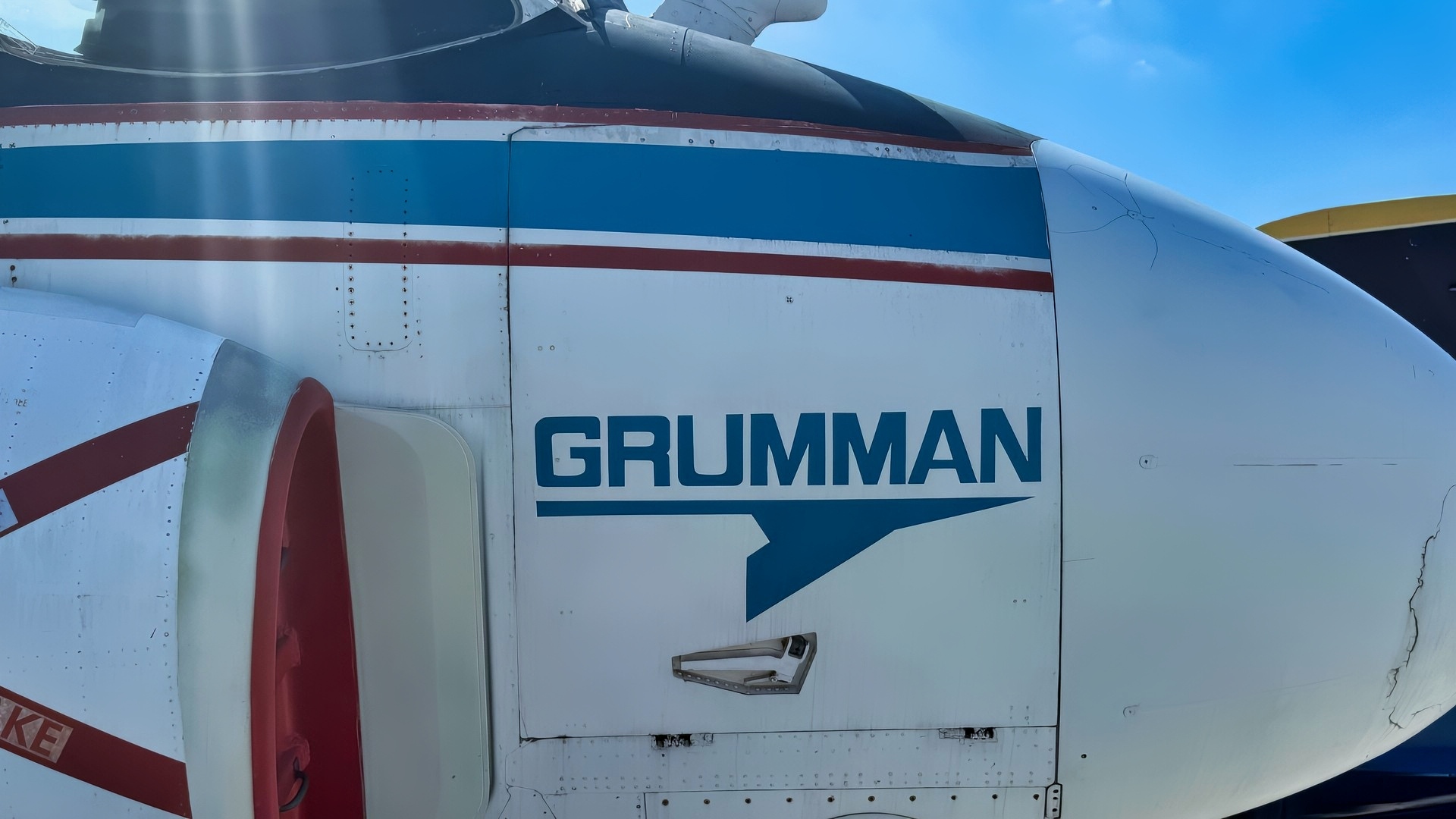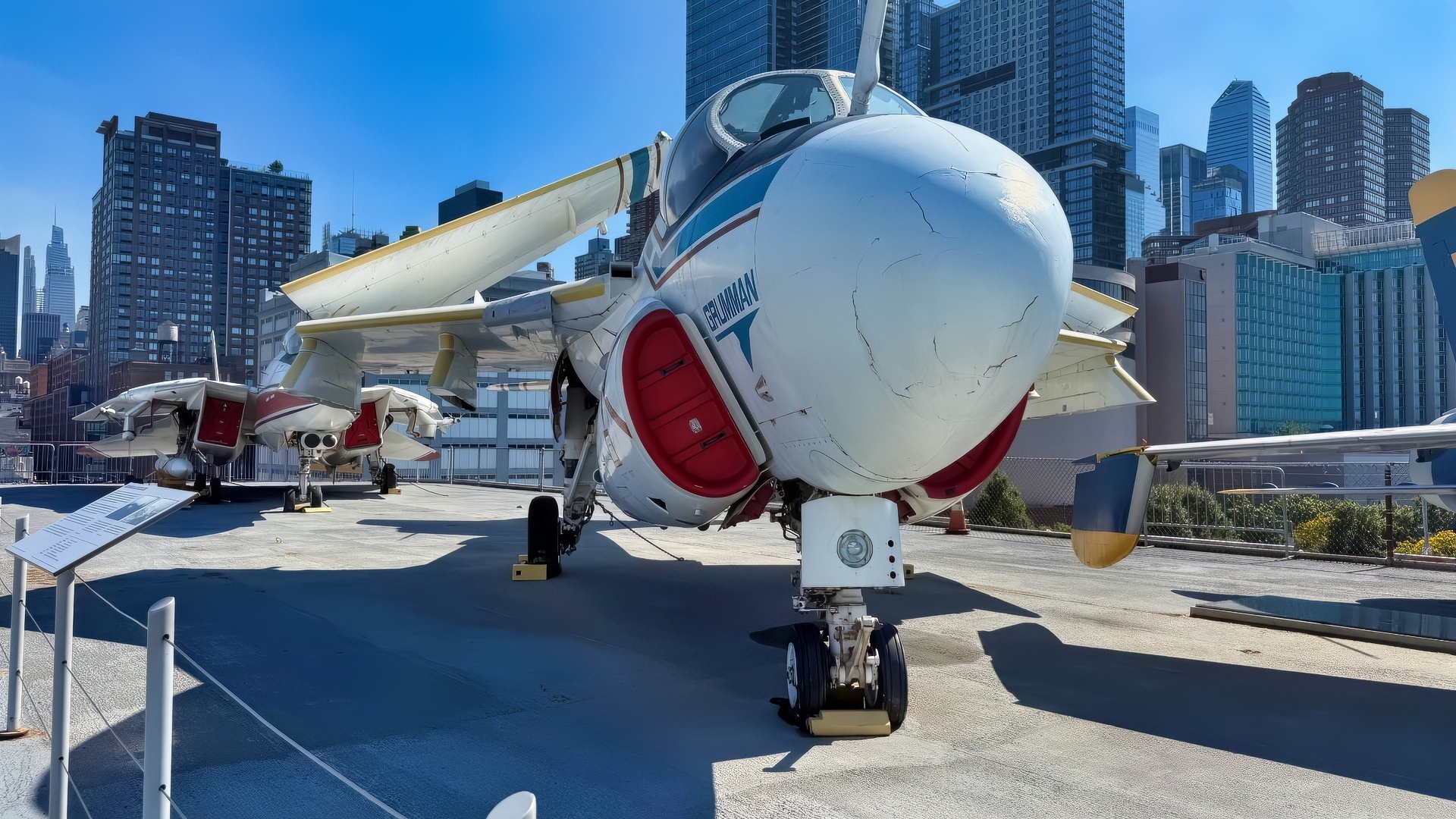Key Points and Summary – The A-6 Intruder was never pretty, but it was one of the U.S. Navy’s most feared strike aircraft.
-Immortalized in Flight of the Intruder, the all-weather A-6 earned its reputation over Vietnam, where its DIANE and later TRAM systems let crews hit targets with precision at night and in bad weather.

Side of A-6 Intruder. Image Credit: National Security Journal.

A-6 Intruder National Security Journal Photo. Image By Jack Buckby Taken on September 18, 2025.
-With side-by-side seating, massive situational awareness, and the ability to haul up to 18,000 pounds of ordnance—including nuclear weapons—the Intruder was a true bomb truck.
-Pilots remember it as rugged, lethal, and oddly lovable, a workhorse that took heavy losses but always brought the fight.
-Bonus: We recently traveled to New York City to see the A-6 Intruder on display on the deck of the USS Intrepid. We included photos from that visit in this article.
A-6 Intruder Has Fascinating Story to Tell
If you remember a 1991 movie called Flight of the Intruder, you may have fond memories of the A-6 Intruder carrier-based all-weather warbird.
Flight of the Intruder featured Willem Dafoe, Danny Glover, and Brad Johnson. The stars enthralled audiences with depictions of the A-6’s daring exploits. The actors played Intruder pilots and commanders frustrated with limited rules of engagement during the Vietnam War.
The fictional pilots took matters into their own hands when they went after an enemy missile installation to carry out a harrowing mission that wasn’t previously allowed by the brass.
The 1960s Stalwart Took Its Licks
In reality, the Intruder was a somewhat hard-luck airplane. Eighty-four were lost during the Vietnam War. The first Intruders in 1963 were called A2Fs, but that nomenclature quickly changed into the Intruder designation due to the airplane’s toughness and performance.
The Intruder had a unique side-by-side seating arrangement. As the Aviation Geek Club explains, it had “Digital Integrated Attack Navigation Equipment (DIANE), which provided an electronic display of targets and geographical features even in low visibility conditions.
Introduced on the A-6E version of the aircraft, the Target Recognition Attack Multisensors (TRAM) system combined Forward Looking Infrared Radar (FLIR)/laser sensors with an onboard computer.”
Pinpoint Targeting Punished the Enemy
All these capabilities were ahead of their time. The A-6’s bombing accuracy was stupendous, and its continuous strike missions took a toll on the enemy, unceasing as they were even at night and in tough weather.
The Navy had such confidence in the A-6 that it sometimes sent the airplane out on solo jet raids—but most of the time it had a wingman.
More Details About the Hollywood Production
The Flight of the Intruder began shooting in 1989 with full encouragement from the Navy. A-6s from the USS Independence (CV-62) were repainted with Vietnam War-era livery.
More than 1,000 sailors appeared as background actors to heighten the realism, and naval aviators flew 285 flight hours during filming.
“Safety was our primary concern because the majority of the film crew had never been on an aircraft carrier,” Capt. Michael T. Sherman said, as reported by Aviation Geek Club. Sherman added that the “Navy was scrupulously watchful of any safety violation and made no exceptions in making sure that only Navy-approved safety equipment was used by the crew during the filming.”
Huge Bombing Payload
Hollywood aside, the A-6 was one impressive airplane, and proved it in action against the North Vietnamese.
Many do not realize that the A-6 was nuclear-capable. Its payload was 18,000 pounds, and it had two powerful turbo-jet engines. It could operate at near-zero visibility and fly at low altitude to confuse enemy radar.
Forging a Path With a Follow-On Strike Wing
Due to the plane’s excellent situational awareness, Intruders sometimes flew as “pathfinders,” serving as the vanguard attackers before follow-on strikes by other airplanes. Later the Navy introduced the EA-6B Prowler to suppress enemy air defenses and radars with anti-radiation missiles and Electronic Warfare capabilities.
What Pilots Experienced in the A-6
The War Zone has an interesting tale about a real A-6 pilot and his exploits. Francesco “Paco” Chierici flew the Intruder. Chierici knew the Intruder’s nickname, the “flying drumstick,” did not do it justice. His story emphasizes its impressive lethality and firepower, and Chierici is a good source for comparing the A-6 to other airplanes: He also flew the F-14 Tomcat.
“The cockpit of the Intruder was radically different as well. The visibility over the big bulbous nose wasn’t as good as the Skyhawk, but the side glass went all the way down to my hip. It was insane, you could practically see underneath the plane without even rolling,” Chierici told the War Zone.
“Paco” was suspicious of the side-by-side seating at first, but he soon grew to like it.
“It was initially irritating to give up half of the cockpit, sacrificing visibility and primacy, to the BN, but I soon discovered that the camaraderie in that cockpit was unlike anything I would ever experience again. We would literally high-five after rolling off-target and spotting the bomb hit,” he recalled. “It was awesome.”
“Without any modifications, the A-6 could carry 28 MK-82 500-pound bombs. If the gear doors were removed, it was an even 30. That was 15,000 pounds of ordnance on a plane that only weighed 27,000 pounds empty. Fill her up with gas and we were launching off the deck in 300 feet, zero to 160 knots, at 60,000 pounds of gross weight,” he said. “That was quite a ride.”
Quite a ride indeed. The A-6 was not the prettiest airplane, but it made up for it with a huge payload, which made it valuable for striking targets in Vietnam. I read the book that inspired the movie at a time when I was fascinated by naval aviation, with plans to go to the Naval Academy and become a pilot.
That never happened, but the A-6 is nevertheless a memorable airplane. It endured some tough combat losses and still delivered when the chips were down.
About the Author: Brent M. Eastwood
Author of now over 3,000 articles on defense issues, Brent M. Eastwood, PhD is the author of Don’t Turn Your Back On the World: a Conservative Foreign Policy and Humans, Machines, and Data: Future Trends in Warfare plus two other books. Brent was the founder and CEO of a tech firm that predicted world events using artificial intelligence. He served as a legislative fellow for US Senator Tim Scott and advised the senator on defense and foreign policy issues. He has taught at American University, George Washington University, and George Mason University. Brent is a former US Army Infantry officer. He can be followed on X @BMEastwood.
More Military
The U.S. Military Purchased 2 Russian-Made Mach 2.35 Su-27 Flanker Fighters
The B-2 Spirit Stealth Bomber Has a Message for the U.S. Air Force
To The Bottom In Minutes: China Has Countless Missiles Ready to Sink U.S. Navy Aircraft Carriers










